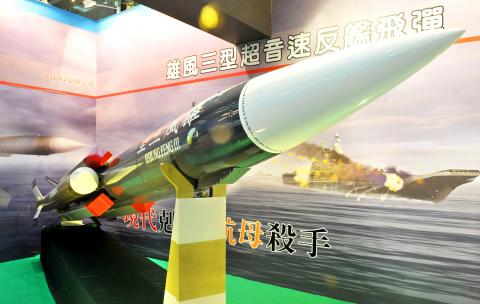In a blunt departure from tradition, the military yesterday displayed a model Hsiung Feng (“Brave Wind”) III (HF-3) anti-ship missile with, as a backdrop, a large picture of a burning aircraft carrier that bore a striking resemblance to China’s retrofitted Varyag, which embarked on its maiden voyage earlier in the day.
The booth, set at a prominent location at the Taipei Aerospace and Defense Technology Exhibition (TADTE), which opens today, was the center of attention of reporters who were given a chance to take a look around during a pre-show visit.
The HF-3, a ramjet-powered supersonic anti-ship missile, can be launched from land and surface platforms, such as Taiwan’s Perry-class frigates. The 130km-range, single-warhead missile has been in development at the Chung-Shan Institute of Science and Technology (CSIST, 中山科學研究院) since 1995. It entered production in about 2007 and is believed to have entered service the following year.

Photo: CNA
The CSIST is administered by the Ministry of National Defense’s Armaments Bureau.
Asked to confirm how many missiles were currently in production or had been deployed, Chiang Wu-ing, deputy director of the Hsiung Feng program at CSIST, would not provide figures.
While the HF-3 had been on display at previous shows, this was the first time it was shown in a context that prominently identified its intended target. Although no flag or ensign could be seen on the computer-generated rendition of the aircraft carrier and accompanying fleet, the “ski jump” ramp and general outlook were oddly similar to the Varyag China acquired from Ukraine in 1998.
Next to the burning carrier were the Chinese characters for “carrier killer,” also the first time the HF-3 had been described as such. It is doubtful, however, that the missile’s 120kg payload would be sufficient to sink an aircraft carrier.
Approached by reporters for comment on the symbolism and timing of the display, a CSIST spokesperson would not directly confirm that the vessel depicted was the Varyag.
For his part, Chiang said that when the HF-3 entered development and even after it had entered production, the Taiwanese military and CSIST could not have known that China would acquire and refurbish the Soviet-era Varyag or embark on a program to develop its own carriers, expected to enter service in about 2020.
Initial reports had said the 60,000 tonne Kuznetsov-class carrier would embark on its maiden voyage on July 1 to coincide with the 90th anniversary of the founding of the Chinese Communist Party, but unexpected developments forced a delay until this month.

Tropical Storm Gaemi strengthened into a typhoon at 2pm yesterday, and could make landfall in Yilan County tomorrow, the Central Weather Administration (CWA) said yesterday. The agency was scheduled to issue a sea warning at 11:30pm yesterday, and could issue a land warning later today. Gaemi was moving north-northwest at 4kph, carrying maximum sustained winds near its center of up to 118.8kph and gusts of 154.8kph. The circumference is forecast to reach eastern Taiwan tomorrow morning, with the center making landfall in Yilan County later that night before departing from the north coast, CWA weather forecaster Kuan Shin-ping (官欣平) said yesterday. Uncertainty remains and

SEA WARNING LIKELY: The storm, named Gaemi, could become a moderate typhoon on Wednesday or Thursday, with the Taipei City Government preparing for flooding A tropical depression east of the Philippines developed into a tropical storm named Gaemi at 2pm yesterday, and was moving toward eastern Taiwan, the Central Weather Administration (CWA) said. Gaemi could begin to affect Taiwan proper on Tuesday, lasting until Friday, and could develop into a moderate typhoon on Wednesday or Thursday, it said. A sea warning for Gaemi could be issued as early as Tuesday morning, it added. Gaemi, the third tropical storm in the Pacific Ocean this typhoon season, is projected to begin moving northwest today, and be closest to Taiwan on Wednesday or Thursday, the agency said. Today, there would likely

DISRUPTIONS: The high-speed rail is to operate as normal, while several airlines either canceled flights or announced early departures or late arrivals Schools and offices in 15 cities and counties are to be closed today due to Typhoon Gaemi, local governments announced last night. The 15 are: Taipei, New Taipei City, Taoyuan, Tainan, Keelung, Hsinchu and Kaohsiung, as well as Yilan, Hualien, Hsinchu, Miaoli, Chiayi, Pingtung, Penghu and Lienchiang counties. People should brace for torrential rainfall brought by the storm, with its center forecast to make landfall on the east coast between tonight and tomorrow morning, the Central Weather Administration (CWA) said. The agency issued a sea warning for the typhoon at 11:30pm on Monday, followed by a land warning at 11:30am yesterday. As of

CASUALTY: A 70-year-old woman was killed by a falling tree in Kaohsiung as the premier warned all government agencies to remain on high alert for the next 24 hours Schools and offices nationwide are to be closed for a second day today as Typhoon Gaemi crosses over the nation, bringing torrential rain and whipping winds. Gaemi was forecast to make landfall late last night. From Tuesday night, its outer band brought substantial rainfall and strong winds to the nation. As of 6:15pm last night, the typhoon’s center was 20km southeast of Hualien County, Central Weather Administration (CWA) data showed. It was moving at 19kph and had a radius of 250km. As of 3pm yesterday, one woman had died, while 58 people were injured, the Central Emergency Operation Center said. The 70-year-old